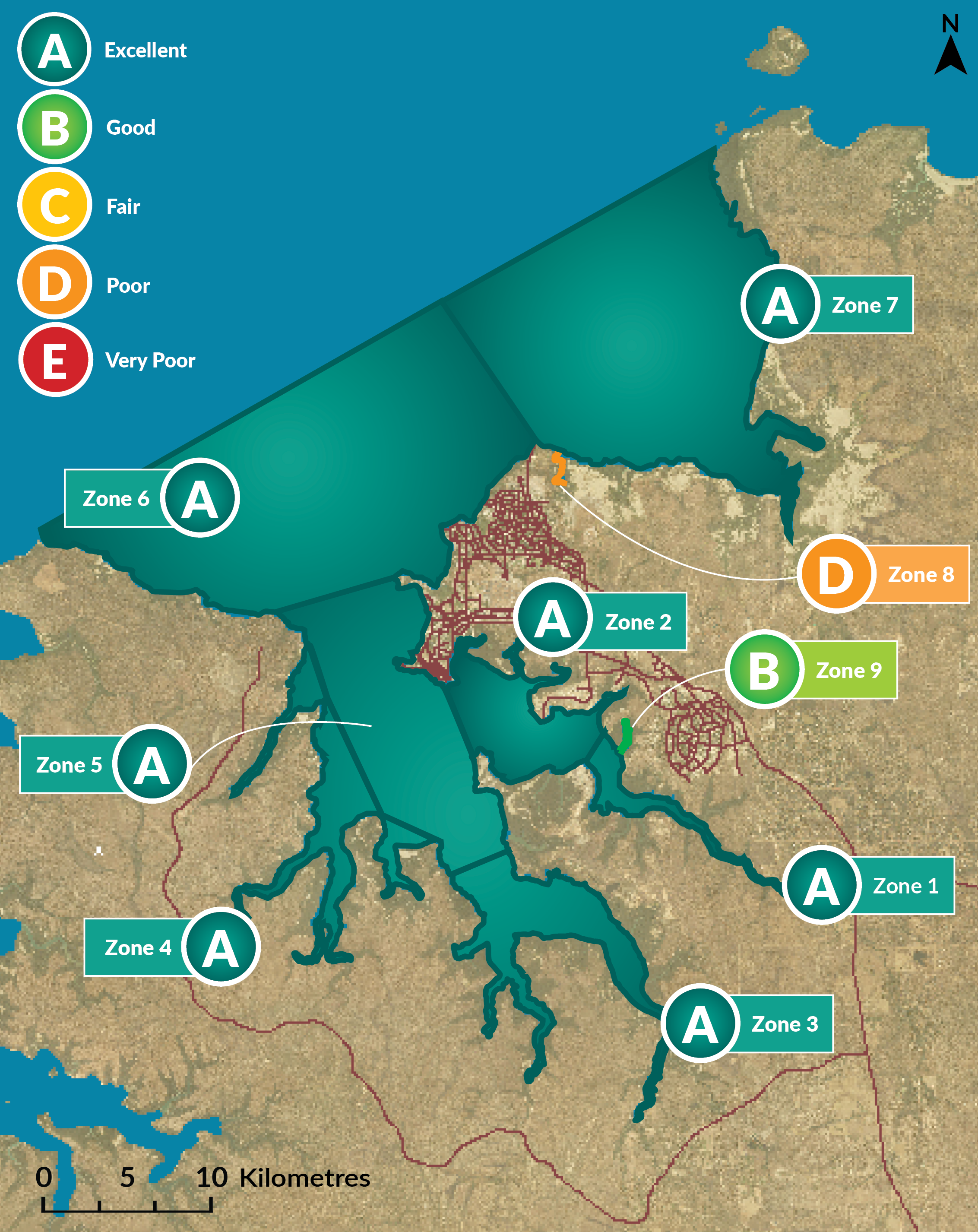Darwin Harbour Report Card 2019
Water quality monitoring in Darwin Harbour
Every year the Darwin Harbour report card assesses the water quality of Darwin Harbour against the Darwin Harbour water quality objectives.
Water quality data were collected by the Aquatic Health Unit of the Department of Environment and Natural Resources and supplemented by monitoring data from Power Water Corporation.
Nine reporting zones represent different physical environments in the harbour, which feature marine biota such as seagrass beds, coral reefs and fringing mangroves.
The Harbour's water quality was graded good to excellent in 2019. An exception was Buffalo Creek estuary, which was impacted mainly by wastewater discharge from the Leanyer-Sanderson sewage treatment plant.
No marine pests were detected in 2019 and the beaches were suitable for swimming throughout the dry season.
How grades are calculated
For each indicator the median value of all the data within a zone is calculated and compared against the Darwin Harbour water quality objectives. These guideline values are locally derived benchmarks to evaluate water quality condition in Darwin Harbour.
The nutrient indicator comprises three sub-indicators, an exceedance for one of the sub-indicators results in a “fail” for the overall indicator.
Report card grades are assigned depending on the number of indicators that are exceeded:
How data are collected and grades are calculated
Grade | Number of indicators exceeded | Water quality rating |
|---|---|---|
| 0 | Excellent |
| 1 | Good |
| 2 | Fair |
| 3 | Poor |
| 4 | Very poor |
In some exceptional circumstances, expert opinion may override the calculated water quality grade.
This may occur because data collection in a particular year was affected by unusual circumstances, or because a very slight exceedance of the water quality objectives for a particular indicator is deemed to be of no ecological consequence.
Report card data collection
Water quality data for the Darwin Harbour report cards were collected during the dry season. Data collection was restricted to neap tides to minimise variability due to tidal influence.
Surface water quality (pH, dissolved oxygen, salinity, temperature and turbidity) was measured at one-second intervals along continuous transects across the nine reporting zones, using a flow-cell method that continuously pumps water through a water quality instrument. More than 27,000 measurements were made in 2019 using this method.
Water samples were also collected from over 100 sites and analysed for nutrients and chlorophyll-a.
Water quality indicators
Four key water quality indicators are assessed for the Darwin Harbour report cards.
| Icon | Indicator | Parameter | Why is this important? |
|---|---|---|---|
| Water clarity | Turbidity | Light is important for microscopic algae and other plants, such as seagrasses, to grow and photosynthesize. Stormwater and dredging can reduce water clarity and affect plant growth. | |
| Dissolved oxygen | Oxygen saturation | Oxygen dissolved in the water is essential for fish and other animals to survive. The amount of oxygen in the water can be reduced by water pollution. | |
| Nutrients | Nitrogen oxide, ammonia and soluble phosphorus concentrations | Nitrogen and phosphorus are nutrients required for algae to grow. However, high nutrient concentrations can increase the amount of algae, resulting in algal blooms which affect the broader environment. | |
| Algae | Chlorophyll-a concentration | These are microscopic plants that may appear as specks in the water, or as a scum floating on the surface. Algae are an important part of the ecosystem in the harbour, but excessive amounts have a detrimental effect on the waterway. |
Water quality objectives
The Darwin Harbour Water Quality Objectives provide locally derived guideline values for water quality indicators in Darwin Harbour.
| Indicators | Sub-indicators | Water quality guideline value | ||
|---|---|---|---|---|
| Upper estuary | Mid estuary | Outer estuary | ||
| Dissolved Oxygen | Dissolved oxygen (% saturation) | 80 to 100 | 80 to 100 | 80 to 100 |
| Water clarity | Turbidity (NTU) | <4 | <4 | <4 |
| Algae | Chlorophyll-a (µg/L) | <4 | <2 | <1 |
| Nutrients | NOx_N (µg/L) | <20 | <20 | <10 |
| Ammonia as N (µg/L) | <20 | <20 | <20 | |
| Filterable Reactive Phosphorus (µg/L) | <10 | <5 | <10 | |
Give feedback about this page.
Share this page:
URL copied!

